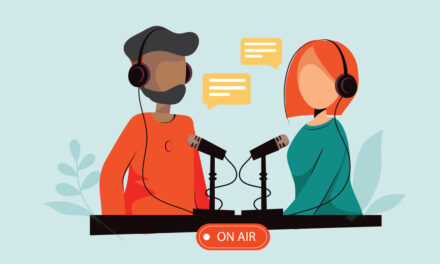During a recent visit to my brother’s house, my sister-in-law pointed out their new Amazon Echo Dot. “It’s so cute,” she said, before showing me her primary use case: “Alexa, tell me a joke!” The sound of Jimmy Fallon’s voice suddenly filled the room with a corny joke that made my sister-in-law laugh as she went about her day.
Later that afternoon, I was in the house alone. In the time-honored tradition of sibling pranks, I decided to ask Alexa a few precisely worded and detailed queries, asking it multiple times and in multiple ways. That’s why it’s likely that my brother and his wife were served up advertisements for bedbug abatement, rash cream, and adult bed-wetting support in their internet sidebars for the next few weeks. (What can I say? It was too good of an opportunity to let pass.)
The incident highlights both the promise and peril of the full-speed convergence of AI, the Internet of Things (IoT), and content. More devices around us listen to our conversations and track our behaviors. They run that massive and growing corpus of end-user data through AI to intuit our needs, then serve us content that we ask for—or that the device thinks we should need, based on the way we interact with it. Companies are faced with opportunities to serve end users with precision and responsiveness that were never before possible. But with that opportunity comes a great deal of ethical concern around privacy, data security, and longer-term implications that may simply be impossible to predict in such a fast-moving industry.
Explosion of Growth
AI and the IoT are shaping the future of consumer and enterprise applications in the digital content industry and beyond. According to the research firm IoT Analytics, the number of IoT devices worldwide currently stands at 7 billion and is projected to reach about 22 billion by 2025. In an August 2018 research brief called “Unlocking Opportunities in the Internet of Things,” Bain & Co. predicted that IoT spending will double from $235 billion in 2017 to reach $520 billion by 2021.
In the meantime, adoption of AI continues to climb at a dizzying pace. Pinterest’s Lens visual search tool, chatbots that can book your next haircut, and Google predictive searches show that AI is fast becoming the default mode for enterprise-based and consumer-based service delivery. The “AI Index 2018 Annual Report,” by a group of policy researchers seeking to provide comprehensive data and analysis on AI, found that venture capitalist funding for U.S.-based AI startups increased 350% from 2013 to 2017, compared to a 100% growth rate for all active U.S. startups.
But if the IoT makes it easier to track and predict user behavior and AI simplifies the task of knowing what the end user needs, they both require content to create engagement and customer satisfaction. The growth in AI and the IoT means that there are more places to drive usage on all those devices and in all those experiences—whether it’s a virtual-reality layer in a physical location, directions and details that appear on a car’s smart windshield, or natural language processing-powered responses to voice searches.
Vince Jeffs, senior director of product strategy for AI and decisioning at Pegasystems, which develops software for customer relationship management, digital process automation, and business process management, says, “AI and IoT have opened up the ways in which people can experience content through increased availability, the ability to consume it in multiple formats, and enhanced quality.”
Raising Complex Ethics Questions
But the merging of AI, the IoT, and content raises a fundamental ethical challenge—how to protect the privacy and security of end users who don’t realize what they are giving away while interacting with the IoT.
Some in the industry regard it as a more comprehensive, and potentially more useful, extension of the way that companies have long tracked customer data. Toby McClean, VP of IoT innovation and technology at ADLINK, which designs and manufactures products for embedded computing, test and measurement, and automation applications, says, “I think the doom and gloom stories are unnecessary. It’s the same trade-off we’ve been dealing with since credit cards came on the market. Those companies have a massive amount of information about you, but we’ve placed our trust in them because of the convenience.”
Sean Byrnes, co-founder and CEO of Outlier AI, Inc., which offers analytic solutions to enable businesses to make better decisions, says, “We didn’t used to have the tools to deal with all the data being gathered from the IoT, so AI has provided a set of tools to actually make use of those mass amounts of data.” Especially in traditional industries (such as manufacturing, shipping, or transportation) in which IoT sensors have made the collection of usage data possible, AI allows organizations without a legacy of complex data analysis to extract knowledge from the deluge of IoT data.
But on the flip side, says Byrnes, “AI for content is having an inverse effect; it has changed people’s relationship with content without them even realizing it,” as ads and feeds become more attuned to an end user’s existing worldview and serve up more of the content that reinforces it. Byrnes feels there’s a risk inherent in the sense of intimacy that AI can bring about especially for end users in the consumer market, creating real vulnerabilities around misinformation.
“It used to be that content producers and end users were aligned; a newspaper would publish articles that it thought its readers would want to buy a newspaper to read. Now you can create the same kind of experience using filter bubbles, where every person sees a different view of the world,” he says. The result, according to Byrnes, is that “everyone’s getting the content they want, but no one is actually happier or better off for it.”
There’s also the intrusiveness of what Jeffs characterizes as “the surveillance economy.” Thanks to retail sensors and smartphone locations, it’s possible for companies to know not just where certain consumers are in a store, but to track the movement of their eyes and quickly send a coupon to their phone related to the object on which those eyes linger. “There’s a ‘creepy factor’ that may turn off some consumers if a company crosses that line,” he says, pointing out that financial institutions and healthcare providers need to be especially sensitive to how much behavioral data they use to engage with end users.
And what happens long term to the personal data gathered by the IoT? Right now, a company collecting a given piece of data on a smart sensor may store and use it a certain way and may even communicate that transparently to the customer, who has the option to provide opt-in approval. But what happens if that company is bought and its data assets are combined with others that a more powerful AI recognizes as coming from the same person?
“Hedge funds are prolific buyers of IoT data,” says Byrnes. When they buy, it’s often to combine with other content for purposes vastly different from that to which the consumer originally consented. “Companies are selling what could be very sensitive market information about consumer behavior that their consumers may not be OK with.” He adds, “Every time I see a story about a new kind of data, I think, ‘OK, which hedge fund is going to buy this, and what will they use it for?’ ”
Opportunities Abound
Even with the risks and complexities of the ways in which organizations leverage AI, the IoT, and content, it’s worth thinking this through to get it right, simply because the potential gains in engagement, efficiency, and productivity are staggering.
Consider a mechanic on a field call who is wearing Google’s Glass while servicing a malfunctioning piece of equipment. ADLINK’s McClean says, “Content relevant to the diagnosis could appear in their glasses as they are working on the fix,” so the technician can fix the problem faster and more efficiently.
ADLINK recently had an example of this convergence of AI, the IoT, and content that was potentially lifesaving. In the aftermath of Hurricane Maria in Puerto Rico, ADLINK worked with an engineering services client that placed gas-powered generators all over the island, some in extremely remote locations, to provide power in the long months while the grid was out. The generators needed servicing about once a week, but some were extremely difficult to reach; workers only spent about 5 minutes at each generator.
“There was a lot of potential for something to go wrong,” says McClean. “So we ‘instrumented’ the generators so they could share the data about performance up through the cloud. That data provided field operators information about which needed to be visited next. Some didn’t need to be visited for 3 weeks at a time; others needed to be visited several times a week.” By collecting the sensor data and providing content in context to technicians about where to concentrate their maintenance efforts, power levels stayed consistent and reliable.
For content providers, the powerful combination of AI and the IoT stands to expand the total amount of content consumed in previously unimaginable ways. To take one simple example: In a future of self-driving cars, passengers will have more time to engage with content via streaming services, social networks, and content libraries. Even now, while drivers still need to keep two hands on the wheel, the AI/IoT combo could enable content providers to serve up local restaurant recommendations and historical information or stream music from local performers through a car’s dashboard, working off its geographical data and driver’s behavioral data.
Transparency vs. Trust
To extract the promise out of the AI/IoT/content trifecta without suffering the negative impacts of real or perceived loss around privacy and security, organizations need to think beyond data transparency into how they can build trust and provide education. It may be the definitive challenge for the coming decade.
The European Union’s General Data Protection Regulation (GDPR) is an example of an externally applied rule meant to put control back into the consumer’s hands in terms of privacy protection and data minimization. But the hard truth is that AI and the IoT are only getting more complex, and it’s unrealistic to expect consumers to understand what data is being collected and what may happen to it down the line.
“What does transparency mean in a world where the bar is so high?” asks Byrnes. “Most people have no idea how Netflix comes up with the recommendations they make for movies. I could explain to someone how that works, but if they don’t have a degree in mathematics or computer science, they probably wouldn’t understand it.” So trust becomes an important part of getting this right, building a track record with end users of treating their data respectfully, securely, and solely for the purposes of serving them better.
McClean says inviting stakeholders into the process early on also helps. He cites the example of an ADLINK client that used cameras to increase the efficiency and accuracy of packing pallets. “Workers were concerned that the cameras were being used to collect data about their performance.” By inviting workers in to see the data being collected and showing them how it could make their jobs easier, they created engagement and trust. Says McClean, “As long as you’re open with [stakeholders] and allow them to see how the data is being used, you mitigate some of the trust issues.”
An inclusive approach to ethics training, security protocols, and data handling should be on every organization’s radar. As more employees have access to the realms of data that AI/IoT create, many of them simply do not possess the knowledge to think through the implications of how it could be misused. “The chief data officer role is becoming multifaceted. Not only must they ensure secure and trustworthy use of organizational data, but they can glean insights from the data that could end up being a new revenue stream,” Jeffs points out.
McClean says that for content creators, the current era of AI and IoT convergence is about the art of the possible. “[Digital content] managers sit on a gold mine of content, and they’re looking for new ways to deliver the content to the consumer that will drive the most value out of it.” He continues, “The questions they should be considering are, ‘What data do I need to make an intelligent decision about delivering the right content to the right person at the right time? And when and where do I need it?’ ”






